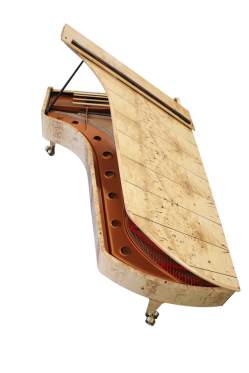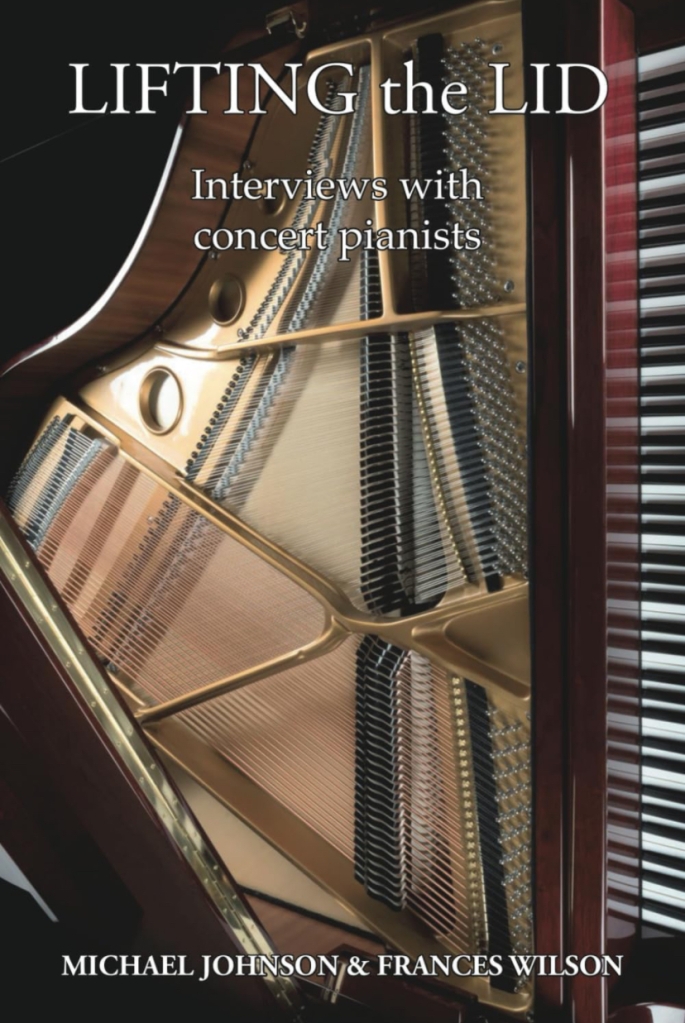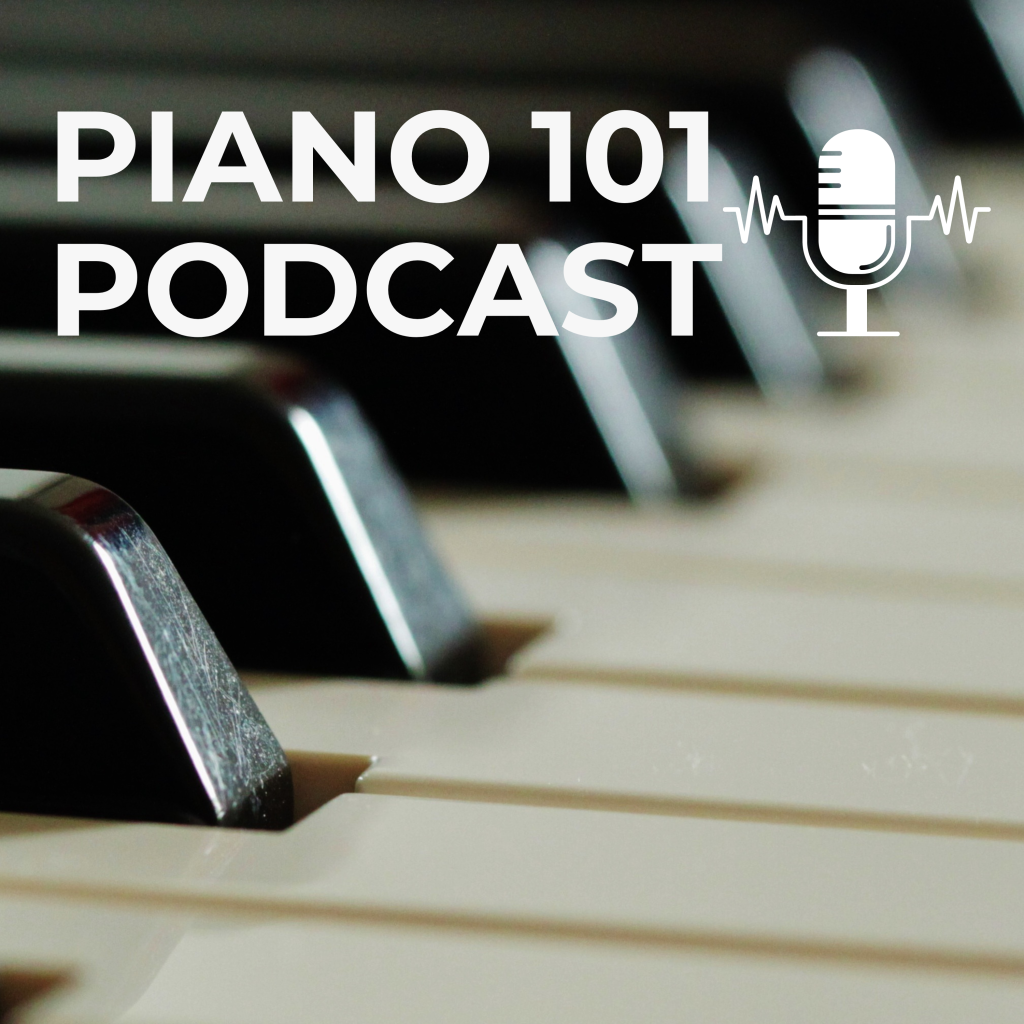Guest post by Michael Johnson
“It’s important,” explains piano builder Wayne Stuart of Tumut, Australia, “to realize that we perceive sound not only through our ears but through all of our body.” That’s how the Big Beleura, his new 108-key concert grand, gets to you.

At the recent world première of the instrument, composer Alan Griffiths had rescored one of his pieces to better exploit the extended range of the keyboard, and pianist Nicholas Young had to play part of it standing up. As he reached inside to strum with his left hand, he played the octave melody on the upper keys, and the audience reportedly loved it.
Young says he finds the extended bass keys “incredibly sonorous even when not in use. They seem to contribute to the entire timbre. It pulses through one’s entire body like an organ pedal note.”
In this excerpt, Young is playing Griffiths’ “Cakewalk from Hell”. The deep bass takes over at 40 seconds :
Stuart has described his expanded keyboard concept in these terms: “Once players have tasted these fruits, they will never willingly return to 88 keys … Can you believe there are players and luddites who think this is crazy?”
And indeed, the premiere audience for the new model was a full house of “very excited”, but not crazy, music lovers who “listened to every note and sprang to their feet” at the climax, Stuart recalled during our week-long exchange of emails recently. Their attention never waned. “Folk were there to get everything they could from the experience.”
As director of Piano Australia Pty Ltd that presides over the manufacture of the Stuart & Sons brand, Stuart believes his new four-pedal expanded keyboard piano may show the way for the first radical advance in piano design in more than 130 years. Certain limited experiments aside (such as Bösendorfer’s Imperial and Daniel Barenboim’s disappointing “Barenboim”), piano architecture has been pretty much frozen since the 1880s.
Not surprisingly, some players and critics remain skeptical. I asked the respected critic and composer Melinda Bargreen of Seattle how excited she is – or isn’t — about the new piano. “I salute Wayne Stuart for pushing musical boundaries,” she wrote in an email exchange with me. “Experimental composers may enjoy tinkering with those extra 20 notes but they must face the fact that their performance opportunities will be extremely limited. The size, price and 1,420-pound weight will make these instruments inaccessible to nearly everyone outside of Australia.” (The Steinway Model D concert grand weighs a mere 990 pounds.)
 And yet the piano is off to a promising start. Beleura House and Garden villa and concert hall on Mornington Peninsula, Victoria, where the premiere was held, was already an attraction for music-lovers and is now boosted by the acquisition of the first Big Beleura.
And yet the piano is off to a promising start. Beleura House and Garden villa and concert hall on Mornington Peninsula, Victoria, where the premiere was held, was already an attraction for music-lovers and is now boosted by the acquisition of the first Big Beleura.
The new piano will come to Europe and the United States only if a buyer will commission a new hand-crafted model. Stuart tells me it would go for about $250,000 and will require a full year to build. In the interim, YouTube videos and a forthcoming Griffiths recording will fill the gap for those of us in the northern hemisphere.
Ashley Hribar, an Australian pianist of German-Slovenian parentage, has logged the most hours on the massive keyboard and praises the “amazing colour” of the piano. He tells me in an interview (see below) that the tone and the touch of the piano proved easier to master than he expected. “After about 30 minutes I felt quite at ease and everything became intuitive,” he said. The 1,492mm (4 feet 10 inch) wide keyboard would be a stretch for a child prodigy but average players seem unfazed. Long-limbed Hribar can reach both ends by leaning forward slightly.
Here he plays Jelly Roll Morton”s “Fingerbeaker”, stretching to reach the deep bass at 1;24.
A modest player and highly trained piano technician, Stuart has added ten notes to the bass and ten to the treble. He is now encouraging composers to come forward to experiment with it. The first to emerge is Brazilian pianist Artur Cimirro with a composition that takes in the full keyboard.
Premiere pianist Young reminds me there is a long tradition of imitating the organ when performing or arranging Bach (e.g. Busoni, von Bülow, Liszt), so the extended sonorities allow the pianist to come even closer to perfecting that illusion. “I imagine that works using extended technique, such as Henry Cowell’s The Banshee, would also be incredibly effective with the extended range, he said. “Duet arrangements of symphonies, like those that Liszt arranged of Beethoven, will sound fantastic.”
The additional keys, made possible in part by technical developments in string metallurgy, rarely carry melody but are effective for percussive effects and resonate when played together at an adjacent octave. I can confirm, after much research, that the effect of these extreme notes does indeed set the body tingling.
The limits of piano wire performance have been pushed by Stephen Paulello Piano Technologies, near Fontainebleau in France, at Stuart’s urging. A super-strong wire suitable for extreme treble keys was first developed in 2012 and toughened up just a year ago to enable the 108-key range.
As new repertoire for the instrument emerges, other works are being amended and adapted to incorporate the highs and lows. Griffiths says he was pleased to hear the “visceral energy” of the deep growling bass with percussive left-hand chord clusters. In his adaptations, he was after an “unworldly sound — primal even — to do what no other piano can do.”
Hribar is also rearranging some of his repertoire, including his own Paganini Variations and Liszt’s Mephisto Waltz Nr 1. “I am hoping many other composers will continue to write for the expanded keyboard,” says Hribar.
———
An edited transcript of email exchanges with pianist Ashley Hribar follows:
How intimidating was it to approach the instrument for the first time and look at 108 keys?
People often say to me, “You must need long arms”, etc. In fact, physically, I don’t find the extra 20 keys make a huge difference. It’s probably more psychological, especially when you hear the number 108 as opposed to 88. One simply needs to extend the arms slightly further or lean a bit to either side. Playing the notes simultaneously on either end, which one rarely does on traditional pianos, does require one to move the head closer to the keyboard. This is no issue for my arm span, but it may be for smaller people.
Did you need a few hours to adapt to the touch and the sound?
It wasn’t so daunting. I had previous experience with the 102-key Stuart & Sons piano. Playing the Brahms Cello Sonata (F Major) was a little scary at first because I had to re-coordinate, sometimes needing a split second to reach octaves in the bass. After about 30 minutes, I felt quite at ease and everything became intuitive.
Did you need adjustment of your sensibilities to appreciate the growling bass notes or the tinkly uppermost register?
Yes, pianists need to adjust to each new brand of piano. My biggest adjustment to this piano has been with physical coordination and adapting a slightly different visual approach to the extra notes. This opening of a new sound world in colour and depth have been inspiring indeed. I’ve had a lot of experience with experimental new music and improvisation and so having access to such an instrument is a true blessing.
Do you find these additional keys suited more to enhancing chords rather than carrying melody?
Yes. The human ear has difficulty distinguishing these extremes of register, especially the last few notes on each end. So, playing melodies in this range can be challenging. From a compositional perspective today, this would depend on one’s approach to melody and something very new. But interestingly, the brain does compensate well by imagining the sound of these notes, especially when playing chromatic scales or broken chords toward these extremes. I think the piano balances and blends the sound, continuing from the traditional range in a way one would imagine.
This is starting to sound like the extremes reached by pipe organs in a grand cathedral.
Yes, much like the pipe organ, particularly those reaching 8 Hz (lowest organ note) and the high register (beyond 8,000 Hz), the listener feels the sound rather than distinguishing the notes. Transferring this to the acoustic piano, the sound of the pipe organ at this range is much different than the range of the Stuart & Sons. Nonetheless, these vibrations give an unexpected dimension to sound, adding depth and warmth to the lower registers and brilliance in the high registers.
Give us an example of improvisation that has worked well.
When appropriate, I add the lower bass notes to enhance the effect of the music. Debussy’s Claire de Lune is an example where at bar 15 and 17 I add the lower E-flat. When playing this note extra soft (ppp), you can feel the vibrations of this note as well as its overtones. This, in combination with the original notes creates an amazing colour.
What kind of repertoire is available and what is in preparation?
Brazilian pianist Artur Cimirro was the first person to write for the 108 key piano. Alan Griffiths has been rearranging and writing wonderful new works for the ‘Big Beleura’ (the 108 key Stuart) in his recent CD Rare View. As for myself, I have been rearranging some of my own compositions, such as my Paganini Variations and adapting traditional works like the Liszt’s Mephisto Waltz Nr 1. Other works of interest here originally written for 102 keys include Black Opal (2000) by Alex Mitchell and various pieces by Fabien Touchard, Charly Mandon and Stéphane Delplace written especially for the French 102 key piano built by Stephen Paulello.
Some composers invited improvisation. Aren’t they a good starting point?
Yes, virtuosic piano music, particularly of the romantic era with composers like Liszt, Alkan and others, show many examples where experimentation is implied. That is, the performer could in some cases use the score more or less as a guide. The lesser-known Hungarian Rhapsodies by Liszt are typical examples where we are left with bare bones on the page, leaving space between the notes to fill out harmonies, add arpeggios, extra notes or completely re-invent passages. These works and many others are perfect opportunities for pianists to use 108 keys.
The Liszt sounds appropriate for the broader sound spectrum.
True, and I have been reimagining Liszt’s Mephisto Waltz No.1, originally an orchestral work and later arranged for piano by the composer. The Peters edition includes alternative passages, suggesting experimentation or implementing personalised embellishments, for example the dazzling flourishes in the right hand. Such deviations from the score were commonplace in the 19th Century, especially with pianists of the golden age like Rachmaninov and Horowitz.
French composers like Debussy, Ravel and Messiaen experimented with rhythm and colour. Ravel writes the G sharp below the A1 in his Piano concerto for the Left Hand, and in Une barque sur l’océan (Mirrors) and Messiaen’s Par Lui tout a ete fait (Vingt regards sur l’Enfant-Jésus). Claire de Lune and many other works show how 108 keys could be used.
Michael Johnson is a music critic with particular interest in piano. He worked as a reporter and editor in New York, Moscow, Paris and London over his writing career. He is the author of five books and divides his time between Boston and Bordeaux. He is a regular contributor to The Cross-Eyed Pianist
Other versions of this article appeared in International Piano magazine and on http://www.factsandarts.com





